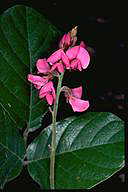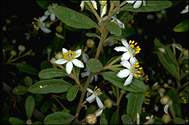

 |
Australian National Botanic Gardens
|
 |
A weekly news sheet prepared by a Gardens' volunteer.
Numbers in square brackets [] refer to garden bed Sections.
Plants in flower are in bold type.
11 November 2005
 |
|
Kennedia retrorsa - click for larger image |
These spring flowers, they bloom beside the stairs, they bloom in the pots and about the buildings. They also bloom further afield where this walk will go with a promise there will be so many boronias to see.
Walk along the road on the far side of the Rainforest, the Queensland Frangipani, Hymenosporum flavum [Section 125] is a small tree with loose yellow perfumed flowers mixing with its glossy leaves. Groups of orchids including Dendrobium x delicatum [Section 125] with sprays of white flowers and thick leathery leaves, appear beside this road. Opposite a group of tea-tree cultivars include Leptospermum ‘Tickled Pink’ [Section 124] a yet small shrub bearing lovely apple-blossom pink flowers. Cross over the Main Path where other orchids including the small pink orchids, Thelychiton kingianus [Section 104] edge the Rainforest.
At the curve the renowned Gymea Lily, Doryanthes excelsa [Section 78] is quite a sight with its large cluster of red flowers atop an extended bare stem surrounded by large strappy leaves. Commersonia fraseri [Section 140] is a tall suckering shrub with clusters of sweet smelling white lacey flowers edging the arching branches. The semi-prostrate Kunzea ambigua [Section 123] is heavy with perfumed white fluffy flowers covering the stems. The top corner has numerous shrubs of Leptospermum rotundifolium ‘Lavender Queen’ [Section 39], so attractive with the lavender coloured open flowers. Then turn left at the bottle tree, Brachychiton rupestris [Section 42] with large swollen trunk, then right, taking the upper small path where Kennedia retrorsa [Section 46] with purple pea-flowers, spreads over the ground.
 |
Asterolasia hexapetala - click for larger image |
Follow this path to the left to a maze of colour. Yet dwarf, Boronia ‘Aussie Rose’ [Section 46] is bright with rich pink flowers while Asterolasia hexapetala [Section 46] is of medium size with a scattering of white starlike flowers. Phebalium woombye [Section 46] is small and well covered with clusters of tiny white flowers. A grouping of Boronia muelleri ‘Sunset Serenade’ [Section 46] is covered with pink star flowers, and behind the taller Boronia ‘Lorne Pride’ [Section 46] is dense with deep pink flowers. Opposite, Boronia ‘Spring White’ [Section 46] is profuse with white flowers, while at that corner Boronia pulchella [Section 46] is yet a dwarf shrub with deep pink flowers. Along this side path, Boronia heterophylla [Section 46] is upright and well covered with almost scarlet cup shaped flowers. Close by Boronia microphylla [Section 46] is a dwarf plant with its lovely pink shaded flowers.
Continue uphill where Grevillea johnsonii [Section 56] wraps its branches ablaze with its curvaceous waxy red and lemon flowers around a tree trunk. Opposite, Philotheca spicata [Section 46] bears its tiny pink flowers along the branches of this dwarf shrub. At the top of the path Banksia petiolaris [Section 56] is a groundcover with underground stems from which upright leaves and maroon flower spikes rising from the earth. Opposite is a waratah, Telopea mongaensis x speciosissima [Section 56] showing off its exquisite red flowers.
There is so much to enjoy up here, including the variety of bird calls …
Barbara Daly.